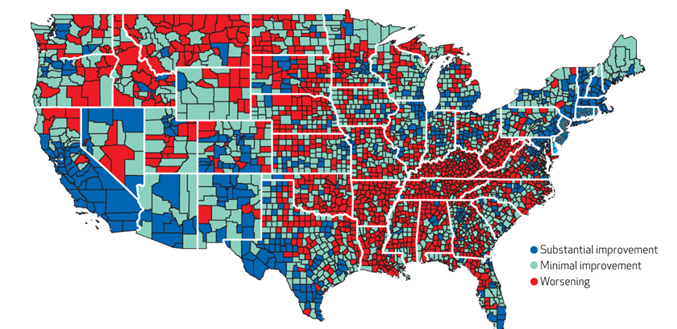
Last week, Wonkblog asked some “interesting, important and influential thinkers” to name their favorite graph of 2013. It was a thrill to learn that Emily Oster, an associate professor of economics at the University of Chicago Booth School, picked a figure from a study that I directed at the National Research Council (NRC) and the Institute of Medicine (IOM).
The graph shows that the United States is slipping further and further behind other high-income countries (mostly those in Western Europe, along with Canada, Australia, and Japan) on life expectancy at birth. The NRC/IOM report looked at the health of Americans through a cross-national prism and showed how we are losing ground across the board: on virtually every measure of morbidity and mortality, at all ages up to age 75, among all races and ethnicities, at all socioeconomic levels, and among both men and women. This large and growing “US health disadvantage,” as the NRC/IOM report calls it, has attracted widespread attention—ranging from a New York Times editorial to a commentary by Rush Limbaugh—since the report was released in January 2013. My own editorial views were published a few months later in the New Scientist and Slate.
As I considered the chart that Oster picked, I wondered if she shouldn’t have picked a slightly different and even more eye-popping figure from our report (and it should be noted that both figures come from a prior related study that inspired our study). This figure shows the probability of women in high-income countries surviving to age 50. As with the Oster figure, the United States is shown in red and the other high-income countries are shown in grey:
Probability of survival to age 50 for females in 21 high-income countries, 1980-2006

The graph shows that US women are less likely to reach age 50 than women in other advanced countries. We are a true outlier in this case. A more recent analysis by scholars at the University of Wisconsin–Madison shows that in many places across the country, mortality among women is actually worsening. In the decade between 1992-96 and 2002-06, female mortality rates actually increased in 42.8 percent of US counties. Here is a map of those counties:
Change in female mortality rates from 1992–96 to 2002–06 in US counties

We really need to get a handle on what’s going on here. As the Urban Institute digs into the social determinants of health in an effort to better understand the US health disadvantage, a key part of this work will be exploring the many drivers of women’s health. Our preliminary analyses suggest that increases in mortality are especially pronounced among white women of reproductive age, not a group we generally think of as being disadvantaged. And finally, because women’s health (and survival) directly affects children and families, we will be looking at their well-being too.
Photo by Manuel Balce Ceneta/AP
Let’s build a future where everyone, everywhere has the opportunity and power to thrive
Urban is more determined than ever to partner with changemakers to unlock opportunities that give people across the country a fair shot at reaching their fullest potential. Invest in Urban to power this type of work.